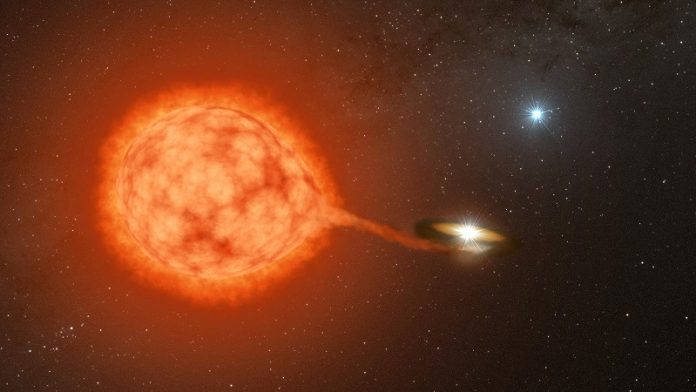
When white dwarfs—the hot remnants of stars like our Sun—are orbited closely by another star, they sometimes steal mass away from their companion.
The stolen matter builds up on the surface of the white dwarf, triggering eruptions called novae.
Theorists have long predicted how these volatile partnerships, called cataclysmic variables (CVs), form, but now a new Caltech-led study reveals a surprising twist: In some cases, a third star, circling farther away from the primary pair, may in fact be the reason the star couple got together in the first place.
“Our results are revealing another formation channel for CVs,” says Kareem El-Badry, assistant professor of astronomy at Caltech and a co-author of a new paper appearing in the Publications of the Astronomical Society of the Pacific. “Sometimes, a lurking third star is key,” he says.
The lead author of the study is Caltech graduate student Cheyanne Shariat.
Before now, scientists believed that CVs formed from a process called common envelope evolution, in which the partner stars are brought closer together via an envelope of gas that cocoons them.
An aging star destined to become a white dwarf expands into a red giant that encompasses both stars, creating a shared envelope. The envelope corrals the two stars, causing them to spiral inward. Eventually, the envelope is ejected, leaving a tight pair that have become close enough for the white dwarf to steal its companion’s mass.
Although a third star was not mentioned in these descriptions, the team wondered if one could be involved. After all, they reasoned, triple-star dynamics do play a role in other types of star systems.
To further investigate the matter, the researchers turned to data from the European Space Agency’s Gaia mission, now retired. Sorting through these observations, they identified 50 CVs in hierarchical triple-star systems, or triples, as the researchers call them. A hierarchical triple is one in which two stars are located fairly close together, while the third is much farther out and orbits the primary pair. The results suggested that at least 10 percent of all known CVs are part of triple systems.
That 10 percent number was higher than what would be expected if triples had no role in CV formation, so the researchers decided to learn more by running computer simulations. They performed so-called three-body simulations on 2,000 hypothetical triples; these simulations sped up the gravitational interactions of the trio of stars, evolving them over time.
In 20 percent of the triple-star simulations, CVs formed without the traditional mechanism of common envelope evolution. In these cases, the researchers say, the third star torqued the main binary.
“The gravity of the third star causes the binary stars to have a super eccentric orbit, and this forces the companion star closer to the white dwarf. Tidal forces dissipate energy and shrink and circularize the orbit,” Shariat says. “The star doesn’t have to spiral in through the common envelope.”
In 60 percent of the simulations, the triple star helped initiate the process of common envelope evolution, bringing the two primary stars close enough to one another to be encased in the same envelope. In the remaining 20 percent of the simulations, the CVs formed via the traditional common envelope evolution route that requires just two stars.
When the researchers accounted for a realistic population of stars in our galaxy, including CVs known to have formed from just two stars, their theoretical models predicted around 40 percent of all CVs form in triple systems. This is higher than the 10 percent they observed using Gaia because, in many cases, the third stars can be either hard to see or have become unbound from the CV.
Finally, the simulation results enabled predictions about the types of triple-star systems that would be more likely to form CVs. Specifically, the triple systems would be expected to start out in wider configurations, such that the tight-knit pair and the third star are separated by more than 100 astronomical units (an astronomical unit, or au, is the distance between the Sun and Earth).
Looking back at the Gaia data, the researchers found agreement: The triples with CVs did exhibit wider separations on average than typical systems.
“For the past 50 years, people were using the spiral-in common-envelope evolution model to explain CV formation,” El-Badry says. “Nobody had noticed before that this was largely happening in triples!”
The study titled “Cataclysmic Variables in Triples: Formation Models and New Discoveries” was funded by the Joshua and Beth Friedman Foundation Fund, NASA, the National Science Foundation, and Howard and Astrid Preston. The project was done in collaboration with Smadar Naoz, a researcher at UCLA who specializes in theoretical studies of triples. Other authors include Antonio Rodriguez, a graduate student at Caltech, and Jan van Roestel of the University of Amsterdam.
Written by Whitney Clavin.



